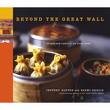 As if I didn’t have enough lovely fiction to read, my favourite cookbook writing duo, Jeffrey Alford and Naomi Duguid have come up with a new one, Beyond the Great Wall: Recipes and Travels in the Other China (Artisan, 2008), which i simply had to buy. When I say I am a fan, I’m not kidding. The Seductions of Rice was the first book of theirs I received, followed by Flatbreads and Flavors and Hot Sour Salty Sweet, abut the cuisines of South Asia. Then last spring, I was searching for meaning in the cookbook aisle and I thought to myself, how wonderful it would be if they wrote a book for India like the one they had done for South Asia. I looked up and, lo, there was Mangoes & Curry Leaves.
As if I didn’t have enough lovely fiction to read, my favourite cookbook writing duo, Jeffrey Alford and Naomi Duguid have come up with a new one, Beyond the Great Wall: Recipes and Travels in the Other China (Artisan, 2008), which i simply had to buy. When I say I am a fan, I’m not kidding. The Seductions of Rice was the first book of theirs I received, followed by Flatbreads and Flavors and Hot Sour Salty Sweet, abut the cuisines of South Asia. Then last spring, I was searching for meaning in the cookbook aisle and I thought to myself, how wonderful it would be if they wrote a book for India like the one they had done for South Asia. I looked up and, lo, there was Mangoes & Curry Leaves.
Why do I like their books so much? Two reasons. First, they’re political. Their attitude towards food and eating is one of both delight and responsibility in a world of scarcity. Their way of eating urges the western world away from making costly (in so many ways) meat the centre of our diet and towards thinking of meat as a delicious accent to a diet based in vegetables and staples like bread and rice. In addition to being guardians of resources, and no more so than in this most recent book, they are guardians of cultures. They are photographers and essayists as well as fine cooks and their stories and pictures document and defend little known cultures and peoples.
The second reason I love their books is that the food is delicious. The receipts typically have modest lists of ingredients and they always work. I admit that my pantry may be better stocked with unusual ingredients than most, but almost everything in their latest book can be made with things you’d find at an ordinary grocery store. It isn’t “restaurant” ethnic food; it tastes more like home cooking, and it is often based directly on dishes they have eaten on their travels, with ordinary people. The classics make way for unusual and unique receipts and their books will not duplicate anything else you have in your collection.
But why take my word for it? I thought I’d make one of their receipts and present it here for you. So, below the fold: Savory Boiled Dumplings! Continue reading “Beyond the Great Wall”
